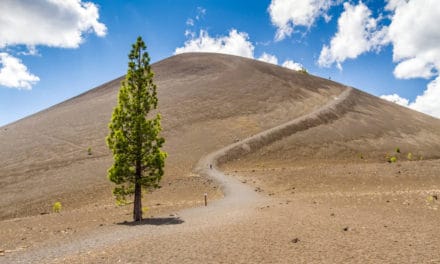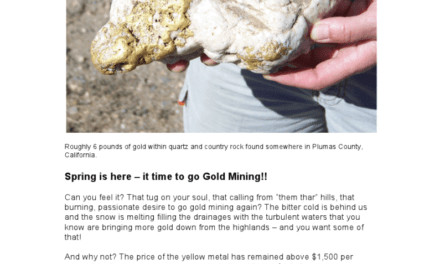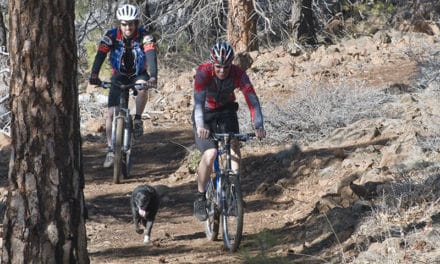By Charles P. Watson
[media-credit name=”stock photo” align=”alignleft” width=”300″] [/media-credit] It is taught in all California schools that GOLD was discovered in California by John Marshall at Sutter’s Mill on January 24, 1848 and this started one of the largest human migrations in United States history. But is this really true? Some will swear by it, others will fight over it, and most historians will tighten their lips and slowly nod their heads. Then why did so many of these 49ers have to fight off the Mexican miners from their already active mines? Kinda makes you wonder how many were already mining gold in California and it was Marshall who first to open his mouth and told the world.
[/media-credit] It is taught in all California schools that GOLD was discovered in California by John Marshall at Sutter’s Mill on January 24, 1848 and this started one of the largest human migrations in United States history. But is this really true? Some will swear by it, others will fight over it, and most historians will tighten their lips and slowly nod their heads. Then why did so many of these 49ers have to fight off the Mexican miners from their already active mines? Kinda makes you wonder how many were already mining gold in California and it was Marshall who first to open his mouth and told the world.
 [/media-credit] It is taught in all California schools that GOLD was discovered in California by John Marshall at Sutter’s Mill on January 24, 1848 and this started one of the largest human migrations in United States history. But is this really true? Some will swear by it, others will fight over it, and most historians will tighten their lips and slowly nod their heads. Then why did so many of these 49ers have to fight off the Mexican miners from their already active mines? Kinda makes you wonder how many were already mining gold in California and it was Marshall who first to open his mouth and told the world.
[/media-credit] It is taught in all California schools that GOLD was discovered in California by John Marshall at Sutter’s Mill on January 24, 1848 and this started one of the largest human migrations in United States history. But is this really true? Some will swear by it, others will fight over it, and most historians will tighten their lips and slowly nod their heads. Then why did so many of these 49ers have to fight off the Mexican miners from their already active mines? Kinda makes you wonder how many were already mining gold in California and it was Marshall who first to open his mouth and told the world.California has more than enough gold to go around and Marshall’s enthusiastic squealing is easily forgiven. California is referred to as the Golden State. This is not because of the exquisite autumn colors, nor the dry grassy fields of the summer. It is because the state is blessed with an abundant amount of gold!It even has a football team named after the men that raced across the country to find their fortunes. The 49ers (the miners not the football team) pioneered trails and roads into the mountains, made settlements that grew into towns and cities, families were raised, and people died.
The gold they found was sold, new supplies were
bought, and they went back to their honey hole, their special place, their mine, and with hard work, a lot of skill, and a little luck, they repeated the cycle for many years. Their children and their children’s children learned the trade and they mined gold. It was a way of life and in many, many cases, it was a very profitable life. One of the largest gold areas in the Golden State is called the Mother Lode Gold Belt – a 400 mile-long, 75-mile wide swath of gold-bearing rocks and gravels in the foothills of the Sierra. Numerous old mining towns dot the trends with names like Seneca, Quincy, Downieville, Nevada City, Placerville, Jackson, Angles Camp, Mariposa, and Sonora. Each have their own history on how the gold was discovered, where were the richer mines, and who were the people that found or lost their fortunes. For some, it is the history of those exciting times that provides them with their wealth,while for others, it is and will always be the yellow metal. Both are compelling, both can be richly rewarding, and both will change how you live your life – if you let it. Plumas County is the northern-most county in the Mother Lode Belt, and was one of the richest gold-bearing counties in California. It is likely that Thomas Stoddard was the first to discover gold in Plumas County. In the summer of 1849, he travelled down the Lassen Trail from Oregon and took a detour westward into Sierra Valley. Stoddard and a few men got separated from their party and became lost somewhere between SierraValley and Downieville. According to the story, they came up along a lake and saw gold nuggets gleaming from the moss along the water’s edge. The men loaded as much gold as their pockets could carry, but were later attacked by Indians and scattered. Stoddard was injured and he never heard
from his companions again. He worked his way down the Yuba drainage to Downieville where he told his tale to other prospectors, who then raced back to the area. News of Stoddard’s discovery quickly spread and more prospectors descended on the region. It is not known the precise location of
Stoddard’s discovery as he was never able to relocate the famed lake where he found his gold nuggets, but is believed to have been in the Gold Lake Basin area – a rightly good name nevertheless, wouldn’t you say?
Meanwhile, a Chico resident named John Bidwell discovered gold in 1848 along the banks of the Feather River about 9 miles from today’s Oroville. He wasted little time in mining what was called Bidwell’s Bar. By the end of 1849, it is reported he had produced more than $100,000 in gold. The price of gold in 1849 was fixed at $18.93 per ounce, which means Bidwell recovered over 5,280 ounces of gold. At today’s prices of $1,500 per ounce, that is
over $8,000,000! Sadly, the famed Bidwell’s Bar now lies at the bottom of Lake Oroville. The dam was completed in 1969 at a time when Americans were forbidden to own gold and gold mining was a thing of the past. More on this next issue.
Bidwell’s success was news all over the state and prospectors descended on the Feather River country in herds, tracing the source of the gold back to Plumas County. Stoddard and Bidwell were directly responsible for the Plumas County gold rush of 1850, both finding gold and telling their stories, which lead people to search the mountains and valleys for their fortunes.
The Plumas County Museum in Quincy is a huge source on information of what happened in the county during the earlier gold rushes. Be sure to check out their exhibits too! The Plumas-Eureka State Park near Johnsville has wonderful displays as well.
Find an expert, a geologist or a miner, and learn from them. Research the internet for more information, tips and techniques. You’ll find gold – there’s no doubt! There is still plenty of it out there. Gold mining is not a new thing, it is something within our blood – something that we feel is right. Today’s miners are smarter than every before. They have better tools to recover the metal and the wisdom to work with Mother Nature. Today’s miners are responsible citizens and reclamation is part of their mining process. It is a thrill to find your first gold speck, flake or nugget. Once you do, you will be
hooked forever. It is fun for the whole family and who knows, maybe, just maybe, if you are a wee bit lucky… you too will jump for joy, click your heels and shout “Eureka I found it!”
Charles P. Watson is the chief geologist at Advanced Geologic
Exploration located in Chester, California. He can be reached at
cwatson@advancedgeologic.com or at www.advancedgeologic.com.
Plumas County Gold!!












